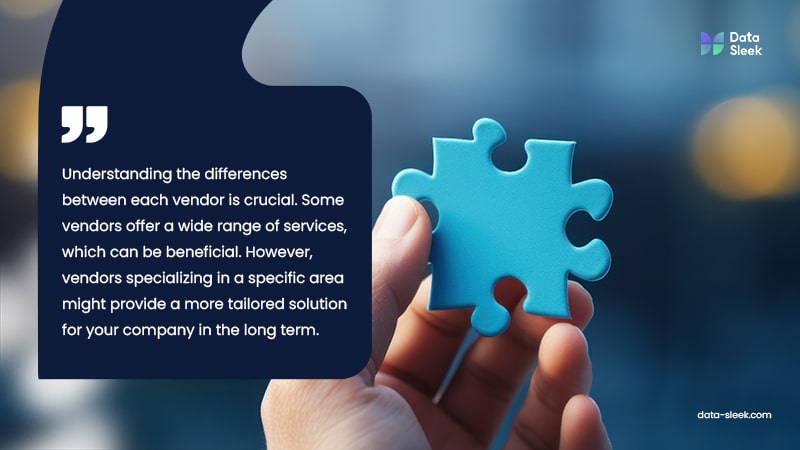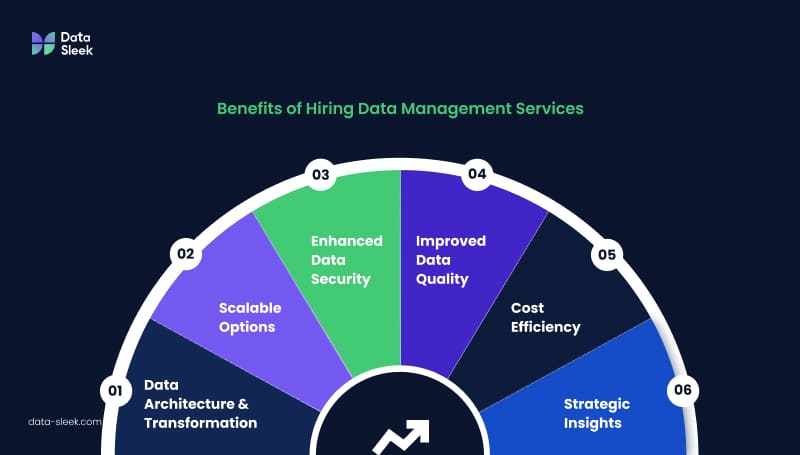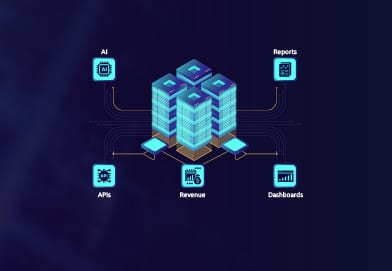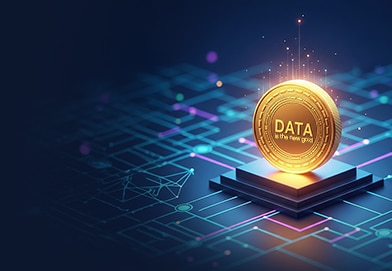Data is the lifeblood of any business like SMBs, but without proper management, it can quickly turn from an asset into a liability. Data management chaos is a common challenge many companies face, often leading to inefficiencies, increased risks, and missed opportunities.
Given these unique data challenges, the benefits of hiring a professional service are worth considering. In this blog, we’ll explore the hidden costs of data management, how it can derail your business, and the steps you can take to regain control and turn your data into a powerful asset.
Key Takeaways
- Effective data management strategies are essential for reducing operational costs, improving data quality, and ensuring compliance with regulatory requirements.
- Professional data management services offer scalable, secure, and cost-efficient solutions that enhance data integrity and support business growth.
- Investing in robust data governance and leveraging expert insights can drive better strategic choices and optimize overall business performance.

What Is Data Chaos?
Data chaos occurs when information from various data sources becomes overwhelming and unmanageable. This results in inconsistencies, inaccuracies, and confusion in decision strategies. Relying more on data for insights often needs help with issues like duplicate records and differing formats. Sometimes, systems don’t communicate well with each other.
“We recently had a customer who had difficulty scaling their BI solution with Tableau because they had data scattered everywhere and did not model it for reporting purposes. At Data-Sleek, dimensional modeling is critical to streamline scale reporting needs and insights,” says Franck, Data-Sleek CEO.
Businesses need to handle their data properly to stay competitive in the market. Without good data governance, your company might face challenges in extracting relevant insights, which can hold back growth and innovation.
What Are the Hidden Costs of Data Management Chaos?
Data management involves collecting, storing, and utilizing big data to ensure accuracy, accessibility, and security. For SMBs, an effective data management system is crucial as it directly impacts their efficiency, decision planning, and ability to scale. However, many SMBs underestimate the hidden costs associated with poor data management, including:

Increased Risk of Cyber Attacks
Poor data management can lead to significant security vulnerabilities. Small and medium-sized businesses (SMBs) are often prime targets for cyberattacks, and a weak data management system and practices exponentially increase the risk of data breaches.
According to DataProt, 1 in 10 small businesses suffer a cyberattack each year. Such breaches can be devastating, resulting in substantial financial losses and severe damage to the company’s reputation.
Opportunity Blindness
With proper data organization, businesses may notice valuable insights and emerging trends. This “opportunity blindness” can prevent SMBs from identifying and capitalizing on growth opportunities. Effective data management strategies are essential for uncovering hidden patterns and making informed decisions that drive business success.
Operational Inefficiency
Disorganized data leads to inefficient business processes and data silos across the organization. Employees waste valuable time searching for information or correcting errors, significantly reducing productivity. A streamlined data management strategy can enhance operational efficiency, allowing staff to focus on more strategic tasks.
Consequences of Inaccurate Data
Data inaccuracies can have far-reaching consequences, resulting in poor decision-making that impacts various aspects of the business, from marketing strategies to customer service. Ensuring there is no missing data and maintaining its accuracy through robust data management strategies is crucial for maintaining the integrity and reliability of business operations.

Uninformed Decision Making
Without accurate and accessible data, businesses must decide based on incomplete or outdated information. This can lead to costly mistakes and missed opportunities. An effective data management strategy ensures decision-makers access reliable data, enabling them to make well-informed choices that drive business growth.
(Source here)
What Is the Impact of Data Chaos on SMBs?
Data chaos can significantly hinder the growth and efficiency of small and medium-sized businesses (SMBs). Addressing these challenges can unlock numerous opportunities and advantages:

- Lost Productivity: Inefficient data management can significantly waste time and resources. According to a study by IDC, data professionals spend 30% of their time searching for information. Employees may spend countless hours searching for information, correcting errors, or dealing with data inconsistencies.
This hampers productivity and diverts attention from more strategic tasks that could drive the business forward. Streamlined data management processes can help reclaim this lost time, allowing teams to focus on innovation and growth.
- Missed Opportunities: Without proper data insights, businesses may overlook potential growth avenues. Data-driven decision-making is crucial in identifying market trends, customer preferences, and emerging opportunities. A report by Forrester indicates that data-driven companies are 58% more likely to beat revenue goals.
Poor data management can obscure these insights, leading to missed chances for expansion and competitive advantage. Implementing robust data management strategies ensures that valuable information is accessible and actionable, enabling businesses to seize opportunities.
- High Management Costs: Ineffective data governance can result in increased operational expenses. Gartner estimates that poor data quality costs organizations an average of $12.9 million every year.The costs of managing disorganized data, including storage, retrieval, and maintenance, can quickly add up.
Additionally, errors and inefficiencies can have a substantial financial impact. By investing in effective data management solutions, businesses can reduce these costs, optimize operations, and allocate resources more efficiently.
- Compliance Risk: Proper data management ensures adherence to regulatory requirements, reducing non-compliance risk. Regulations such as GDPR, CCPA, and HIPAA impose strict data handling and protection guidelines. Failure to comply can result in hefty fines and legal repercussions. A robust data governance framework helps businesses stay compliant, safeguarding their reputation and avoiding costly penalties.
How Data Chaos Affected Hyperwolf
Hyperwolf faced significant challenges due to data chaos. As they scaled to two locations, their data management became increasingly tangled, almost tanking the business. Disorganized data led to inefficiencies, lost productivity, and mounting operational costs.
By implementing a comprehensive data management service, Hyperwolf was able to streamline its processes, regain control over its data, and continue its growth trajectory. This transformation highlights the importance of effective data management strategies in overcoming data chaos and driving business success.
7 Steps in Creating an In-House Data Management Strategy
Developing a data management strategy internally can be highly rewarding, allowing you to tailor solutions to your business needs. Here are practical steps to guide you through the process:

- Identify Business Objectives: Align your data strategy with your business vision by clearly defining your goals, improving operational efficiency, enhancing customer data strategy and insights, or driving innovation. Establish clear objectives to guide your strategy and ensure your data initiatives support your business goals.
- Assess Your Current Data Landscape: Evaluate your existing data infrastructure, including data sources, storage solutions, and data quality, to identify gaps and areas for improvement. This will form the foundation for your data management strategy.
- Conduct thorough research on various vendors to understand their offerings. Examine their expertise, technology stack, and customer reviews to gauge their reliability and effectiveness. Identify vendors that can provide the best solutions for your specific needs and challenges.
- “Understanding the differences between each vendor is crucial. Some vendors offer a wide range of services, which can be beneficial. However, vendors specializing in a specific area might provide a more tailored solution for your company in the long term.” – Franck Leveneur.
- Compare Companies: Evaluate which vendors best meet your specific needs by considering scalability, cost, ease of integration, and the level of support they provide. Make an informed decision that aligns with your long-term business strategy and operational requirements. Not all vendors are created equal. Consider whether your organization requires a hands-on and inclusive approach.
- Develop a Data Governance Framework: Establish policies and procedures for data management, including data ownership, access controls, and data quality standards, to ensure consistency, security, and compliance with a robust data governance framework. Key elements include defining who is responsible for data assets, implementing permissions to safeguard data, and maintaining high data accuracy and reliability.
- Implement Data Management Tools and Technologies: Select and deploy the appropriate data management tools and technologies to support your data management strategy, considering data integration platforms, data warehouses, and data analytics tools. Ensure these solutions align with your business goals and can scale with your growth.
- Train and Empower Your Team: Invest in training programs to equip your team with the necessary skills and knowledge to manage and utilize data effectively. To ensure effective data management, foster a data-driven culture by empowering your employees with data literacy, tool proficiency, and security awareness. Not sure where to start? Data-Sleek offers extensive and customized training programs for businesses like yours.
- Monitor and Optimize Your Strategy: Regularly review and assess the effectiveness of your data management platform using key performance indicators (KPIs) to measure success and identify areas for improvement. Continuously optimize to ensure your data management strategy and data governance remain aligned with your business objectives and adapt to changing needs.
Avoid These Pitfalls of In-House Data Management Strategies
While developing a data management strategy in-house has its advantages, it’s essential to be aware of potential challenges to ensure success:
Blindness to Your Blind Spots
Internal teams may sometimes overlook vulnerabilities due to familiarity with existing data management processes. An external consultant can provide a fresh perspective and identify areas for improvement that might take time to be apparent. This objective viewpoint can uncover hidden inefficiencies and opportunities for optimization that internal teams might miss.
Expertise
Industry professionals possess in-depth knowledge of vendor offerings and market trends. Their expertise can help you navigate the complexities of data management and make informed decisions that align with your business goals. Leveraging their experience ensures you utilize the most effective tools and strategies tailored to your needs.
Sustainability
It’s crucial to strike a balance between ambition and practicality. Companies may sometimes need to work on strategies, leading to costly and underutilized systems. A well-thought-out approach ensures that your enterprise data management strategy is sustainable and cost-effective. Also, a manageable and scalable system can help you avoid unnecessary expenses and ensure long-term success.
Efficiency Drain
Managing data management teams in-house can drain your efficiency, as constantly checking for updates and steering the team diverts focus from core business activities. Outsourcing streamlines the process by allowing you to communicate expectations once, with the outsourced team’s manager handling the rest, ensuring seamless operations without your continuous involvement.

What Are the Benefits of Hiring Data Management Services?
Professional data management services can significantly reduce the cost of poor data management. Here’s how:
- Data Architecture and Transformation: Experts design and implement efficient data structures tailored to your business needs. They ensure your raw data is organized, cataloged, accessible, and secure, enabling effective strategic planning. This foundational work streamlines operations and enhances data integrity across your organization.
- Scalable Options: Cloud-based and subscription models offer flexibility and scalability to meet evolving needs. These solutions allow you to adjust resources based on demand, ensuring you only pay for what you use. This adaptability supports growing businesses, facilitating expansion without significant upfront investment.
- Enhanced Data Security: Professional services prioritize data security, implementing robust measures to protect sensitive information. They stay updated with the latest security protocols and compliance requirements. Safeguarding your data against breaches and unauthorized access is a top priority.
- Improved Data Quality: Experts employ advanced tools and methodologies to maintain high data quality. They help clean, validate, and enrich your data, ensuring accuracy and reliability. High-quality data enhances the effectiveness of data analysis and business intelligence efforts.
- Cost Efficiency: Outsourcing data management reduces overhead costs associated with maintaining an in-house team. Professional services provide access to specialized skills and technologies without extensive training or infrastructure investment. This cost efficiency allows better resource allocation across critical business areas.
- Strategic Insights: Consultants bring a wealth of experience and industry knowledge. They offer strategic insights and recommendations that align with your business objectives. Optimizing data management practices helps achieve goals more effectively.
What Are the Emerging Trends in Data Management?
Staying ahead of the curve in data management requires awareness of emerging trends and technologies. Here are some key trends to watch:

Artificial Intelligence and Machine Learning
AI and ML revolutionize data management by automating complex processes and providing deeper insights. These technologies can help businesses identify trends and anomalies and optimize operations. According to Markets and Markets, the global AI market is expected to grow at a CAGR of 22.8% by 2028 (USD 70.2 billion), highlighting the increasing importance of AI in data management.
Advantages:
- Trend Prediction: Anticipate market shifts and customer behavior.
- Anomaly Detection: Identify and address irregularities swiftly.
- Operational Optimization: Streamline processes for enhanced efficiency.
Data Privacy and Compliance
With growing concerns about data privacy, businesses must ensure compliance with regulations such as GDPR and CCPA. Implementing comprehensive customer data management practices that prioritize privacy and security is essential for maintaining customers’ trust and avoiding legal repercussions.
Advantages:
- Regulatory Compliance: Adhere to legal standards and avoid penalties.
- Customer Trust: Build and maintain a trustworthy brand image.
- Data Security: Protect sensitive information from breaches.

Cloud-Based Solutions
Cloud-based data management solutions offer scalability, flexibility, and cost-efficiency. As more businesses migrate to the cloud, leveraging these solutions can provide a competitive edge. Grandview Research reports that the global cloud computing market will grow at a CAGR of 21.8% by 2030, driven by the increasing adoption of cloud-based services.
Advantages:
- Scalability: Easily adjust resources to meet demand.
- Flexibility: Access big data from anywhere, anytime.
- Cost-Efficiency: Reduce infrastructure and maintenance costs.
Data Democratization
Empowering employees with data analytics tools can drive innovation and improve resolution. Data democratization ensures that data is accessible to all relevant stakeholders, fostering a data-driven culture within the organization.
Advantages:
- Enhanced Strategic Choices: Equip teams with the data they need.
- Innovation: Foster a culture of creativity and finding solutions.
- Collaboration: Improve cross-departmental communication and synergy.
Real-Time Data Analytics
Real-time data analytics enables businesses to make timely decisions based on current information. This capability is particularly valuable in dynamic industries where rapid response to changing conditions is crucial. Real-time data analysis can enhance agility and responsiveness, providing a competitive advantage.
Advantages:
- Timely Decision Process: Act on the most current data available.
- Agility: Quickly adapt to market changes and opportunities.
- Competitive Edge: Stay ahead of competitors with rapid insights.
Transform Your Data Management Strategy With Data-Sleek
At Data-Sleek, we craft tailored data management strategies that drive business success. Our team of experts works closely with you to understand your unique requirements and deliver solutions that enhance productivity and efficiency.
Contact us today to discover how Data-Sleek can transform your data management approach and propel your business forward.







